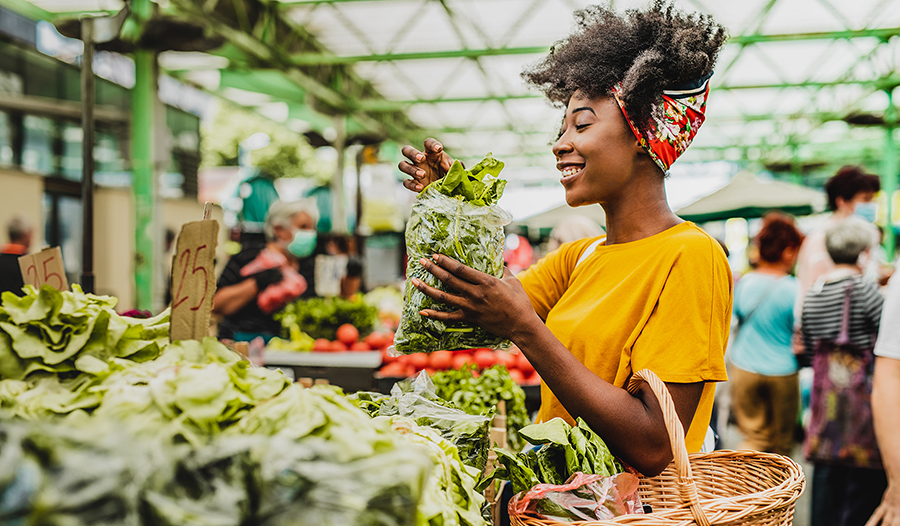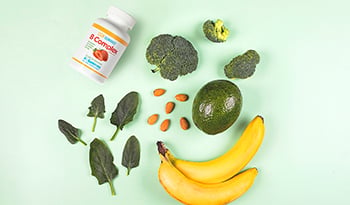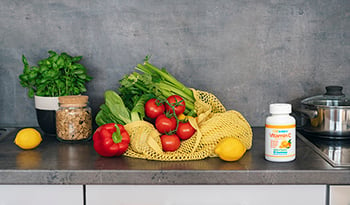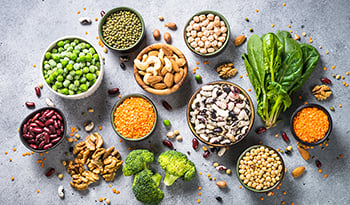How To Transition To A Plant-Based Diet
DISCLAIMER:This blog does not intend to provide diagnosis...

You’ve probably noticed the growing popularity of plant-based eating. In fact, a recent Nielsen survey revealed that 39% of Americans are actively trying to consume more plant foods. Perhaps opting for a plant-based diet has piqued your interest, but you’re unsure about the best way to go about it, or maybe you’re concerned that it will just be too difficult to do.
Here’s a guide to help you make the transition to a plant-based diet. We’ll focus on a few areas to get you started: determining your why, picking a plant-based diet, identifying plant-based foods, and reducing meat intake.
1. Determine Why You Want to Transition to a Plant-Based Diet
Before you take on any major change in your lifestyle, it’s always a good idea to clearly identify your motivation and what your goals are. If you have a good understanding of why plant-based eating is important to you, then you’ll be better able to maintain focus and less likely to stray off track should difficulties arise.
Reasons for a plant-based diet may include:
Compassion for Animals: Many farm animals spend their lives in crowded environments where there is little room to engage in their natural behaviors. Oftentimes, they suffer through this existence only to endure slow and painful deaths.
Reduction of Environmental Impact: Studies have shown that the food production system for a meat-based diet requires more land, energy, and water resources than that of a plant-based diet. Additionally, the meat industry is one of the biggest producers of greenhouse gas emissions, and therefore significantly contributes to climate change.
Desire for Health Benefits: Research has demonstrated that plant-based eating can be effective for weight loss and reducing the risk of chronic diseases such as diabetes, cardiovascular disease, and certain types of cancers. A plant-based diet may also help decrease blood pressure, lower cholesterol levels, and manage blood sugars.
2. Decide Which Plant-based Diet Will Work For You
- Semi-vegetarian or flexitarian eating involves mostly plant foods with the flexibility to occasionally allow meat or animal products.
- Pescatarian is a plant-based diet plan that includes fish and seafood, but no meat or poultry. Many pescatarians will also eat eggs and dairy foods.
- Vegetarian diets do not include meat, but do allow for various animal products. Lacto vegetarians consume dairy, but do not eat meat, fish, eggs, or poultry. Ovo vegetarians do not eat meat, fish, dairy, or poultry, but allow for eating eggs. Lacto-ovo-vegetarians will eat eggs and dairy, but not meat, fish, or poultry.
- Vegan dieting excludes animal foods of any kind.
3. Plan And Prepare to Eat a Plant-based Diet
Create a plan for what you will be eating each week. Unless you have the budget to eat at a vegan or vegetarian restaurant for every meal, being able to prepare your own food at home will be critical to your success in adopting a plant-based diet. So spend a little time looking through cookbooks or researching recipes online. Learn how to cook and season plant proteins properly so that you can enjoy eating them.
Plant-Based Grocery Staples to Stock up on
Stock up on healthy plant foods that you want to eat. It’s harder to fall back into old eating habits when you never run out of plant-based options. It’s also easier to stay on track if you don’t have access to the foods you wish to avoid. Clean out your kitchen, removing items like dairy and meat products.
Some common items you might consider including in your plant-based pantry and refrigerator:
- Grains and pasta: Rice, oats, couscous, quinoa (a pseudo-grain), whole-wheat pasta, brown rice pasta
- Beans and legumes: Peas, lentils, edamame, tempeh, chickpeas, black beans, kidney beans, black-eyed peas
- Flours and baking products: Whole wheat flour, blanched almond flour, baking soda, cacao powder, carob powder
- Sweeteners: Stevia, monk fruit, raw agave, maple syrup, coconut sugar
- Nuts and seeds: Almonds, cashews, pecans, walnuts, flaxseed, chia seeds, sesame seeds, pumpkin seeds
- Jarred and canned goods: Coconut milk, tomatoes, vegetable broth, pickles, sauerkraut, olives, almond butter
- Dried fruit: Apricots, coconut flakes, dates, raisins, cranberries
- Spices: Basil, bay leaves, cayenne, cilantro, cinnamon, cumin, curry, fennel, garlic powder, ginger, Himalayan salt, onion powder, paprika, parsley, red pepper flakes, rosemary, thyme, turmeric, vanilla extract, white pepper
- Oils and vinegars: Olive oil, coconut oil, sesame oil, apple cider vinegar, balsamic vinegar, red wine vinegar, rice vinegar
- Produce: Apples, carrots, celery, limes, lemons, bananas, brussels sprouts, avocados, tomatoes, onions, sweet potatoes, zucchini, broccoli, mushrooms, bell peppers, dark leafy greens, salad greens
- Refrigerator and freezer items: Tofu, tempeh, non-dairy milk, miso, salsa, frozen fruits and vegetables.
- Other foods: Tamari, nutritional yeast, seaweed, lemon juice, coconut aminos.
4. Start Reducing Your Consumption of Meat
You don’t have to give up your favorite foods right away. Make easier changes first. Eliminate the animal foods that you don’t eat very often anyway. It’s okay to start slow.
In the beginning, try going meatless just one day per week. Meatless Mondays is a popular trend you may want to incorporate in your start-up plan.
Add More Plants to Your Diet
Instead of lamenting about what you’re removing, focus on what you’re adding. Increase the number of vegetables you eat, making them fill about half your plate at lunch and dinner. If you’re preparing soup, stir in some beans and kale. If you’re making a sandwich, throw some sprouts and cucumber slices on it.
Shift Your Thinking When it Comes to Meat
Instead of making meat the star of your meals put it in a supporting role. Use a smaller amount of it. Perhaps think of it as a garnish. During the first few weeks, while you explore using plant proteins like lentils, tofu, or tempeh as your centerpiece, you can start reducing the portion size of your meat. This is a way of training your brain not to fixate on meat as the core of the meal. Then it will be much easier to eventually go meatless.
Use Good Fats
Another great way to distract your mind from the absence of meat is to pay attention to fat. Adding a good fat can make a meal truly satisfying. Choose from healthy fats like olives, nuts, seeds, olive oil, avocados, and nut butters. These are plant-based fats that may have benefits such as improving skin appearance, providing hormone support, and increasing levels of HDL (the “good” cholesterol).
Make Your Breakfasts Plant-Based
Once you’ve gotten used to going meatless one day per week, take the next step of adding more plant-based meals to your week. A good place to start is at the beginning of your day—breakfast! It’s one of the easiest meals to make vegetarian or vegan. You can whip up some chia pudding or have some avocado toast. You can even throw some vegan protein powder into your pancake batter before you fire up your griddle. Try my vegan pancake recipe below.
Use a Stepwise Process to Eliminate Animal Foods
You may want to try a plan like this. Work towards having meat only once a week before finally eliminating it. Then start reducing your dairy consumption. First, you can replace cow’s milk with non-dairy alternatives like almond milk or coconut milk. Next, remove cheese from your diet. From there, move on to eliminating all other dairy, like cream, yogurt, and sauces. The final step could be to exclude eggs.
Get Enough Vitamin B12
Vegans and vegetarians run the risk of B12 deficiency, which can cause anemia or nervous system damage. Vegan sources of vitamin B12 include B12 supplements and foods that have been fortified with B12 (check the labels of plant milks, soy products, and breakfast cereals). The way your body absorbs B12 depends on how often you consume it. The less frequently you take in B12, the higher the quantity you need to consume in order to absorb the desired amount.
To get adequate vitamin B12, it is recommended to do one of the following:
- Eat fortified foods two or three times per day, getting at least 3 micrograms of B12 per day.
- Take one B12 supplement of at least 10 micrograms daily.
- Take a weekly B12 supplement of at least 2000 micrograms.
Vegan Protein Pancakes Recipe
Ingredients:
- 1 cup whole wheat flour
- ¼ cup vegan protein powder
- 1 Tbs. baking powder
- ¼ tsp. salt
- 1 cup almond milk (or any other dairy-free milk)
- 2 Tbs. melted coconut oil (or olive oil)
- 2 Tbs. maple syrup
- 1 tsp. pure vanilla extract
Instructions:
- In a large bowl, sift the dry ingredients together.
- Mix the liquid ingredients together in a separate bowl.
- Pour the liquid ingredients over the dry ingredients and combine until only a few lumps remain. (Do not overmix. Otherwise, your pancakes will be tough.)
- Let your batter rest for 5 minutes.
- Lightly oil a frying pan, if needed, and put it on medium-high heat. Once a drop of water sizzles in the pan, it is hot enough.
- Pour about 1/4 cup of batter into the pan.
- Cook for 2-3 minutes until small bubbles form on the surface of the pancake, then flip.
- Cook for another 1-2 minutes until golden brown on both sides. Serve hot.

 By Dr. Venus Ramos, M.D.
By Dr. Venus Ramos, M.D.


